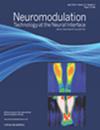Phase-Amplitude Coupling in Response to Transcutaneous Vagus Nerve Stimulation: Focus on Regions Implicated in Mood and Memory
IF 3.2
3区 医学
Q2 CLINICAL NEUROLOGY
引用次数: 0
Abstract
Objective
This study aimed to investigate whether transcutaneous vagus nerve stimulation (tVNS) at different frequencies affects phase-amplitude coupling among regions of the brain linked to mood and memory disorders using simultaneous magnetoencephalography (MEG) in healthy participants.
Materials and Methods
Phase-amplitude coupling was measured among brain areas in response to different stimulation frequencies of tVNS using concurrent MEG and tVNS in 17 healthy participants. The 4 protocols were: 24 Hz cymba concha, 1 Hz cymba concha, PFM cymba concha, and 24 Hz ear lobe. A driven autoregressive method was used to estimate the coupling among brain areas in different physiological frequency bands in response to these protocols.
Results
Different tVNS stimulation protocols led to alterations in phase-amplitude coupling among multiple brain regions linked to mood and memory, notably the prefrontal cortex, hippocampus, and temporal pole. Stimulation delivered at 24 Hz was observed to decrease delta-gamma coupling within the temporal pole and cingulate cortex when contrasted with 24-Hz sham stimulation.
Increased alpha-gamma coupling was observed between the hippocampus and prefrontal cortex when contrasting 24 Hz with pulse-frequency–modulated stimulation. Finally, a comparison of 24-Hz with low-frequency 1-Hz stimulation showed an increase in theta-gamma coupling within the prefrontal cortex.
Significance
To our knowledge, this study represents the first attempt to quantify phase-amplitude coupling in response to tVNS and suggests that different stimulation frequencies can modulate coupling between different areas of the brain. Abnormal phase-amplitude coupling has been linked to multiple mood and memory disorders. Further investigations using different stimulation frequencies of tVNS to alter phase-amplitude coupling may lead to the development of tVNS as a therapeutic option for different medical conditions.
经皮迷走神经刺激反应的相位振幅耦合:关注与情绪和记忆有关的区域。
目的:利用同步脑磁图(MEG)研究不同频率的经皮迷走神经刺激(tVNS)是否影响与情绪和记忆障碍相关的大脑区域之间的相幅耦合。材料与方法:对17名健康受试者进行脑相幅耦合实验,采用脑磁图与脑相幅耦合实验同时进行。4种方案分别是:24 Hz的铙钹、1 Hz的铙钹、PFM的铙钹和24 Hz的耳垂。采用驱动自回归方法估计不同生理频段脑区之间的耦合对这些方案的响应。结果:不同的电视刺激方案导致与情绪和记忆相关的多个大脑区域,特别是前额皮质、海马和颞极之间相振幅耦合的改变。与24赫兹的假刺激相比,24赫兹的刺激减少了颞极和扣带皮层内的δ - γ耦合。与24 Hz脉冲频率调制刺激相比,海马和前额皮质之间的α - γ耦合增加。最后,对比24赫兹和低频1赫兹的刺激,发现前额皮质内的θ - γ耦合有所增加。意义:据我们所知,本研究首次尝试量化对tVNS反应的相幅耦合,并表明不同的刺激频率可以调节大脑不同区域之间的耦合。相幅耦合异常与多种情绪和记忆障碍有关。进一步研究使用不同的tVNS刺激频率来改变相幅耦合,可能会导致tVNS作为不同医疗条件的治疗选择的发展。
本文章由计算机程序翻译,如有差异,请以英文原文为准。
求助全文
约1分钟内获得全文
求助全文
来源期刊

Neuromodulation
医学-临床神经学
CiteScore
6.40
自引率
3.60%
发文量
978
审稿时长
54 days
期刊介绍:
Neuromodulation: Technology at the Neural Interface is the preeminent journal in the area of neuromodulation, providing our readership with the state of the art clinical, translational, and basic science research in the field. For clinicians, engineers, scientists and members of the biotechnology industry alike, Neuromodulation provides timely and rigorously peer-reviewed articles on the technology, science, and clinical application of devices that interface with the nervous system to treat disease and improve function.
 求助内容:
求助内容: 应助结果提醒方式:
应助结果提醒方式:


